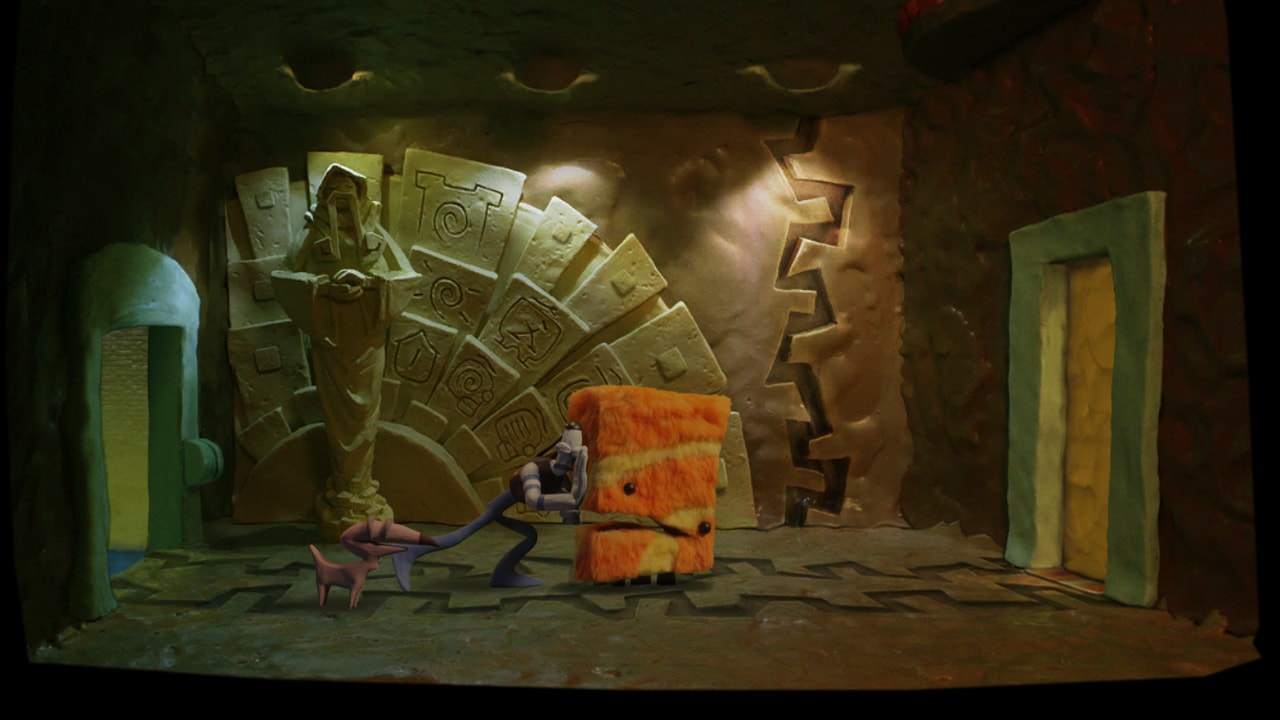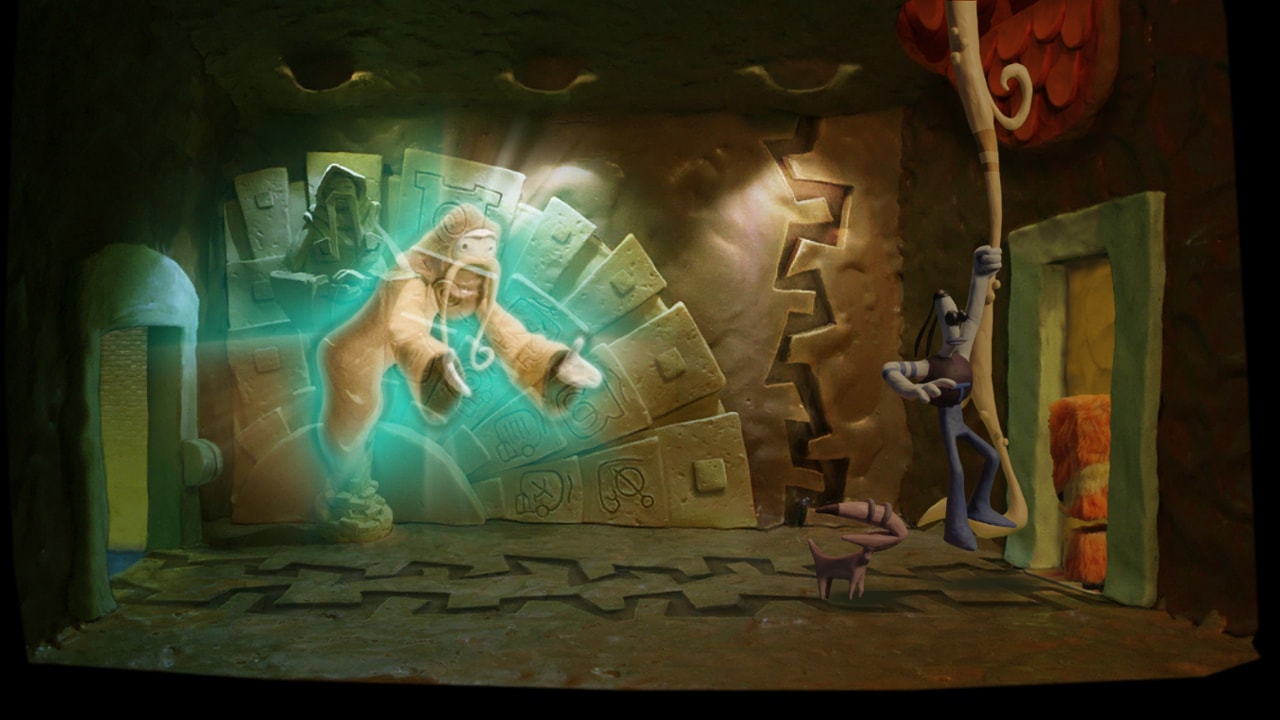Armikrog kicks off with one heck of an opening sequence. A catchy tune and some hand-drawn animations tell the story of Tommynaut, a bumbling astronaut who, along with his faithful psychic canine Beak-Beak, must scour the galaxy in search of a rare energy source required to save his own dying world. Upon colliding with a stray asteroid, the astronaut’s ship plummets down onto the surface of Spiro 5, a planet which may indeed hold the key to Tommynaut completing his quest.
At this point, the cut scene gives way to Armikrog’s ace in the hole – it’s signature claymation visual style. Our heroes emerge from the wreckage of their ship as hand-moulded plasticine models, ready to begin their adventure. The fingerprints of Earthworm Jim creator Doug TenNapel are literally all over this game, with equal parts attention to detail and quirky, offbeat peculiarity given to not only the characters and environments, but to the weird, slapstick humour as well.
After a rather amusing encounter with a ferocious alien beast, Tommynaut and Beak-Beak find refuge in nearby fortress, at which point the player takes control. Inspired by point-and-click adventures from the nineties, such as it’s own spiritual successor The Neverhood, Armikrog relies on the player’s nostalgic fondness of the genre to push the story forward. Offering up next to nothing in the way of tutorials and even going to far as to push the story into the background, it seems like all hope is pinned on a tedious assortment of puzzles and item-hunting in a bid to keep you engaged.
The controls may not be dictated to you through narrated chatter or on-screen prompts, but are still relatively simple to deduce. The left analogue stick and the X button on the Playstation controller take on duties normally associated with a mouse. An on-screen arrow cursor will change into a hand when you hover over something you can interact with, be it switch, object, or even Beak-Beak. Meanwhile there’s no HUD, inventory or even dialogue options to worry about. Everything is streamlined to make the experience as smooth as possible.
On the one hand this works well on the PlayStation 4. There’s no need to switch between menus or fumble around trying to figure out which item (stashed within your belly) you need to progress deeper into the fortress. However, on the other hand, this removes much of the challenge normally associated with games of this genre. If you have the required object or item in your possession then generally speaking, Tommynaut will know exactly what goes where, eliminating the need for careful examination.
But while the game is kind enough to offer you a helping hand with trivial pursuits such as finding and using the correct items, it completely reverses this trend on some of the other puzzles on offer throughout the game. One puzzle in particular had me opening a secret room by turning a crank four or five times. Proud I’d discovered this without any assistance from the game, I quickly lost my patience when after about thirty minutes of aimless wandering, I learned that there was another hidden room in the exact same location.
It wouldn’t be the last time the game would regurgitate the same puzzle and throw it my way. Mosaic boards that open up new areas of the fortress give the illusion of upping the ante every time, but the same principle can be applied to the handful of extra tiles these offer and you’ll soon realise that the secret of Armikrog can be solved with a good memory, rather than deep investigative skills. Remembering clues that can only be seen from Beak-Beak’s perspective or that are offered to you on a silver platter by ants posing as former US Presidents may seem fit in with the game’s wacky style. But Armikrog plays the long game, forcing you to think back to seemingly meaningless symbols and sound bytes you’d encountered many rooms ago, with no rhyme or reason as to how these fit in with the story.
Much of what makes Armikrog such a joy to explore gets lost in the needless repetition of what is essentially a four-hour experience. Not only is the plot delivered in an expositional fashion, rather than told through gameplay, but we have to sit through it twice. Sort of. Tommynaut’s pet, Beak-Beak is actually a playable character in the game and will often discover key story moments, albeit in an indecipherable alien language. As imaginative as these cut scenes are, which initiate when Beak-Beak talks to octopus like creatures scattered around the fortress, they mean absolutely nothing until we’re forced to sit through them all again in sequence from Tommynaut’s perspective later in the game.
Ultimately, Armikrog is let down by it’s wasted potential. What appears to be a point-and-click revival on the surface is nothing more than a tedious memory quiz upon further investigation. The striking hand-crafted visuals may lure you in, but the heat of expectation causes them to quickly melt once the game truly begins. Nothing tops the fantastic opening sequence and all the effort that has gone into bringing these claymation delights to life gets left behind in the vacuum of the fortress that players have to explore.
REVIEW CODE: A complimentary Sony Playstation 4 code was provided to Bonus Stage for this review. Please send all review code enquiries to press@4gn.co.uk.
Subscribe to our mailing list
Get the latest game reviews, news, features, and more straight to your inbox
Thank you for subscribing to Bonus Stage.
Something went wrong.
-
Gameplay - /10
0/10
-
Graphics - /10
0/10
-
Sound - /10
0/10
-
Replay Value - /10
0/10









